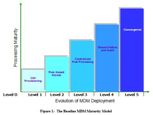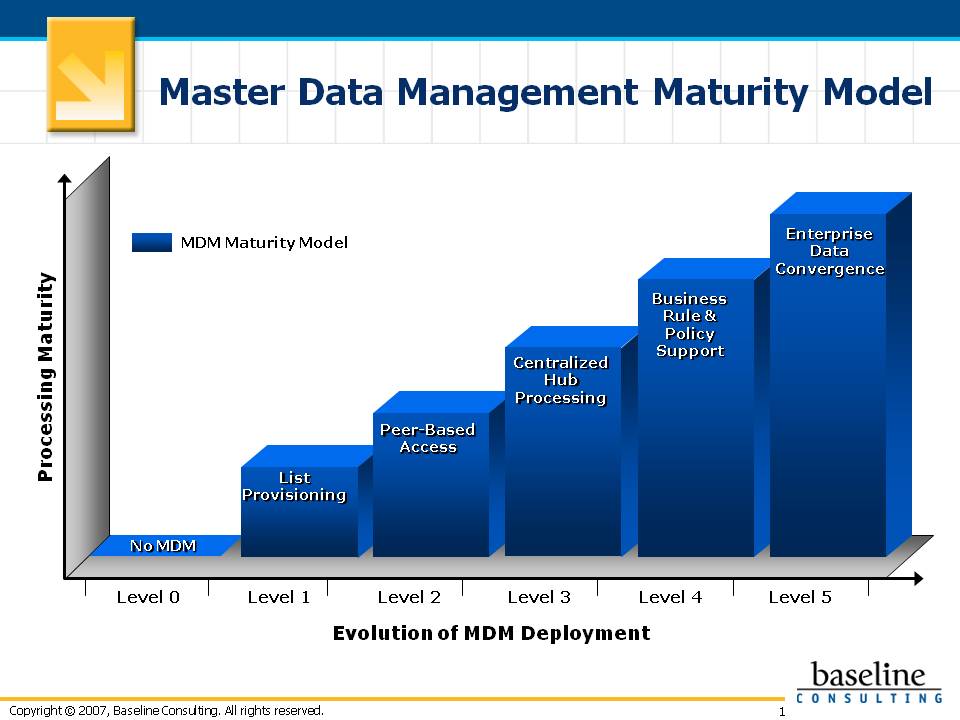
White Paper Excerpt
The Baseline on Master Data Management: Five Levels of Maturity for Master Data Management
A closer look at the dimensions of MDM and an introduction to an MDM maturity model
In this excerpt from their white paper, "The Baseline on MDM: Five Levels of Maturity for Master Data Management," Jill Dyché and Evan Levy cut through the buzz words and marketing hype to explain what MDM is (and isn't), explore its goals, and examine what factors are truly important in your MDM initiative.
- By Jill Dyché, Evan Levy, CBIP
- January 5, 2009
As the MDM market takes shape, IT and business managers are increasingly left scratching their heads at the current crop of buzzwords and their relevance to their own environments. Vendors seeking to expand their markets declare new MDM categories and terms often inviting more confusion than clarity. The result is inertia as companies continue to struggle integrating their silo-ed data amidst the amplified din of confusing vendor messages.
In our book, Customer Data Integration: Reaching a Single Version of the Truth (Wiley), we define MDM as “the set of disciplines and methods to ensure the currency, meaning, and quality of a company’s reference data within and across subject areas and systems.” This lofty definition colors in the depth and complexity of MDM initiatives. Put more simply, MDM ensures that your systems leverage and re-use common, accurate business data.
The case study companies profiled in our book, as well as our MDM early-adopter clients, have taught us an important lesson: how master data is used has little or no bearing on MDM maturity. Terms like “collaborative” or “analytical” MDM only serve to muddy the waters when it comes to MDM functionality. It’s how the master data is stored, accessed, and propagated to the enterprise that indicates MDM’s evolution in an enterprise. While data usage adds complexity to the MDM debate—and may even enrich the requisite MDM “marketecture” diagrams of some vendors—it’s in fact ancillary to how the company manages, integrates, and deploys its master data.
Many MDM newcomers continue to discuss the topic in terms closer to relational databases, but most robust MDM solutions aren’t designed as reporting databases (many business people would argue that there are enough of those already!). MDM systems contain more detail than a simple subject area reference list; they can contain all of the necessary details to support item identification, relationship details, security and access, as well as administrative and management of a company’s reference data. This means that the MDM system not only contains the subject area content (for instance, product id and description), but provides a means of supporting business rule-based information management. Traditional relational databases don’t automate business rules—this is normally the domain of the operational applications or specialized “bolt-on” application utilities. MDM solutions centralize not only the authoritative version of the data, but embed the business rules necessary to ensure that the data is validated, standardized, reconciled, and aligned with corporate policy.
MDM is more than a single image of data. Successful MDM implementations enable business data to contain rigorous and standardized content that reflects business-based logic and rules processing. In addition to offering a solution for the widespread “single version of the truth” goal, MDM offers automated tracking and reconciliation of data from different sources. MDM can provide data access without requiring the applications themselves to retain specific business rule or data navigation logic (as is required when using traditional database technologies). MDM allows the migration of data-oriented rules away from individual applications so they can be attached, and uniformly shared, with the data asset.
The goal of most MDM solutions is in ensuring that master data includes reference details that reflect the current state of the business. As with most complex business-enabling technologies, this doesn’t happen in one development iteration. Consequently we’ve identified five stages of MDM maturity, shown in Figure 1, that can help you gauge your company’s MDM evolution and offer a structured and deliberate pathway forward.
 View Full Size Image
View Full Size Image
It’s important to state here that the MDM maturity taxonomy reflects degrees of complexity and sophistication. It seeks not to be prescriptive as much as to elucidate the various functions that MDM provides, and what’s involved in making them work. Our purpose here is to help crystallize the various functions you need from MDM, and map them to your company’s capabilities. It’s independent of the current crop of tools and technologies: most of today’s vendor solutions will work within all levels of the taxonomy. Each MDM level supports, indeed builds upon, the capabilities of the prior level. Consider the taxonomy less a recommendation of steps—your company may or may not need to go all the way to MDM Level 5—and more of a progression of states.
This article is excerpted from the white paper The Baseline on MDM: Five Levels of Maturity for Master Data Management by Jill Dyché and Evan Levy. The entire white paper is available for download when you take the TDWI/Baseline MDM Readiness assessment survey.
About the Authors
Jill Dyché is an acknowledged speaker, author, and blogger on the topic of aligning IT with business solutions. As the vice president of SAS Best Practices, she speaks, writes, and blogs about the business value of analytics and information.
Prior to being acquired by SAS in 2011, Jill was a partner and cofounder of Baseline Consulting, where she combined the roles of best practices expert, industry gadfly, key client adviser, and all-around thought leader. At both firms, she has led client strategies and market analysis in the areas of data governance, business intelligence, master data management (MDM), CRM, and big data.
Jill’s first book, e-Data (Addison Wesley), has been published in eight languages. Her book The CRM Handbook (Addison Wesley) is the bestseller on the topic. With Evan Levy, Customer Data Integration (John Wiley and Sons) was the first book on the topic of MDM and discussed managing data as a strategic asset. Jill has contributed to a range of other books and her work has been featured in leading publications including Computerworld, CIO Magazine, the Wall Street Journal, the Chicago Tribune, the Harvard Business Review blog, Forbes.com, and Newsweek.com. Her latest book, The New IT: How Technology Leaders Enable Business Strategy in the Digital Age, profiles executives from companies including Comerica, Brooks Brothers, Mylan Pharmaceuticals, Canadian Tire, Union Bank, Mandalay Resort Group, Men’s Wearhouse, and Toyota Financial Services, highlighting the roles they played in transforming IT and driving strategy.
Evan Levy, CBIP, is a management consultant in enterprise data strategy, data management, analytics, and systems integration. Business is experiencing exponential growth in data volumes, sources, and systems. Evan advises clients on strategies to address business challenges using their existing data and technology assets coupled with new and creative methods and practices. With more than 25 years of experience consulting with clients, Evan leads classes and workshops offering practical, real-world experience to address challenges in a manner that utilizes existing skills coupled with new methods to ensure IT and business success.